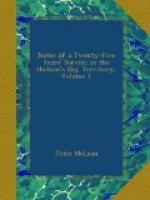To enumerate the varieties of animals is an easy task; the extremely barren nature of the country, and the severity of the climate, prove so unfavourable to the animal kingdom, that only a few of the more hardy species are to be found here: viz.—
Black, brown, grisly, and polar bears.
Black, silver, cross, blue, red, and white foxes.
Wolves, wolverines, martens, and the beaver (but extremely rare).
Otters, minks, musk-rats, ermine.
Arctic hares, rabbits, rein-deer; and the lemming, in some parts of the interior.
When we consider the great extent of country that intervenes between Ungava and the plains of the “far west,” it seems quite inexplicable that the grisly bear should be found in so insulated a situation, and none in the intermediate country: the fact of their being here, however, does not admit of a doubt, for I have traded and sent to England several of their skins. The information I have received from the natives induces me to think that the varieties of colour in bears mark them as distinct species, and not the produce of the same litter, as some writers affirm. Why, otherwise, do we not find the different varieties in Canada, where the grisly bear has never been seen? The sagacious animals seem to be well aware of their generic affinity, since they are often seen together, sharing the same carcass, and apparently on terms of the most intimate fellowship.
It is a singular circumstance, that she-bears with young are seldom or never killed; at least it is so extraordinary a circumstance, that when it does happen, it is spoken of for years afterwards. She must, therefore, retire to her den immediately after impregnation; and cannot go above three months with young; as instances have occurred of their being found suckling their young in the month of January, at which period they are not larger than the common house-rat, presenting the appearance of animals in embryo, yet perfect in all their parts.
Bruin prepares his hybernal dormitory with great care, lining it with hay, and stopping up the entrance with the same material; he enters it in October, and comes out in the month of April. He passes the winter alone, in a state of morbid drowsiness, from which he is roused with difficulty; and neither eats nor drinks, but seems to derive nourishment from sucking his paws. He makes his exit in spring apparently in as good condition as when he entered; but a few days’ exposure to the air reduces him to skin and bone.
The natives pay particular attention to the appearance presented by the unoccupied dens they may discover in summer: if bruin has removed his litter of the preceding winter, he intends to reoccupy the same quarters; if he allows it to remain, he never returns; and the hunter takes his measures accordingly.
The black bear shuns the presence of man, and is by no means a dangerous animal; the grisly bear, on the contrary, commands considerable respect from the “lord of the creation,” whom he attacks without hesitation. By the natives, the paw of a grisly bear is considered as honourable a trophy as the scalp of a human enemy.




